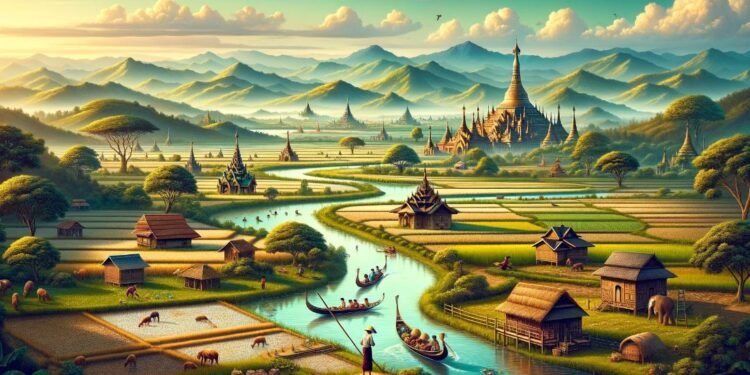Introduction to Burma
Burma, officially known as Myanmar since 1989, is rich in history, culture, and natural beauty. Nestled in Southeast Asia, it is bordered by China, Laos, Thailand, Bangladesh, and India. This geographical positioning has made Burma a melting pot of various ethnicities, languages, and religions, contributing to its unique cultural tapestry. The country’s long and complex history, marked by periods of conflict and isolation, has shaped its current socio-political landscape.
Historical Background
Burma’s history is a tapestry of powerful kingdoms, colonial rule, and the struggle for independence. The earliest civilizations, such as the Pyu and Mon, were established around 200 BCE. The Bagan Kingdom, existing from the 9th to the 13th centuries, is notable for creating an early Burmese culture and for its remarkable architectural achievements, including thousands of Buddhist temples. The 19th century saw the advent of British colonialism, drastically altering Burma’s socio-economic fabric. The struggle for independence was fervent and culminated in 1948, though it led to decades of military rule that isolated Burma from much of the world.
Geography and Natural Resources
Burma’s geography is as diverse as its history. It spans from the Himalayan foothills to the Bay of Bengal, encompassing fertile plains, vast river systems like the Irrawaddy, dense forests, and pristine beaches. This geographic diversity supports a rich array of biodiversity and natural resources. Burma is endowed with precious stones like rubies and jade and has substantial untapped mineral and oil reserves. However, exploiting these resources has been a source of conflict and environmental concerns.
Cultural Mosaic
The cultural landscape of Burma is a vibrant mix of ethnicities, languages, and traditions. The Burmese, forming the majority, have a culture deeply influenced by Buddhism, visible in their art, literature, and festivals. Besides the dominant Bamar culture, there are numerous ethnic groups like the Shan, Karen, Rakhine, and Rohingya, each with distinct traditions. This diversity is a source of richness but has also led to ethnic tensions, particularly evident in the plight of the Rohingya people.
Buddhism and Religious Practices
Buddhism plays a central role in Burmese society. Theravada Buddhism profoundly influences daily life, values, and customs here. Magnificent pagodas and monasteries, such as the Shwedagon Pagoda in Yangon and the Mahamuni Buddha Temple in Mandalay, are not just tourist attractions but vital religious sites. While Buddhism is predominant, there is also a significant presence of Christianity, Islam, Hinduism, and traditional animist beliefs, reflecting the country’s religious diversity.
Economic Landscape
Burma’s economy is an exciting mix of agriculture, industry, and services. Agriculture employs most of the population, with rice being the primary crop. Despite rich natural resources, decades of isolation and internal conflict have hindered economic development. However, since the 2010s, there has been a gradual opening, with foreign investment and tourism injecting new life into the economy. The country faces significant challenges, including poverty, inadequate infrastructure, and ongoing ethnic and political conflicts that impact economic stability and growth.
Political Landscape and Human Rights
The political scenario in Burma is complex and marked by decades of military rule, brief periods of democratic governance, and ongoing conflicts with various ethnic groups. The military has been a dominant force in Burmese politics, often suppressing dissent and controlling critical management. The 2015 election, which brought the National League for Democracy (NLD) to power, was seen as a significant step towards democracy, but the military retained considerable influence. The situation of human rights in Burma is concerning, with reports of ethnic cleansing, particularly against the Rohingya Muslims, restrictions on free speech, and political repression.
Tourism in Burma
Tourism in Burma has been growing, thanks to its rich cultural heritage and natural beauty. Key attractions include the ancient city of Bagan, Inle Lake, and the untouched beaches along the Andaman Sea. However, tourism is also a double-edged sword, bringing economic benefits but sometimes leading to cultural erosion and environmental degradation. Given its political situation and human rights issues, the ethical considerations of traveling to Burma also make it a complex destination for many international tourists.
Challenges and Future Prospects
Burma stands at a crossroads today. While it has immense potential due to its rich resources and cultural heritage, it faces significant challenges. These include ethnic conflicts, human rights issues, and the need for economic and political reforms. The path to a peaceful and prosperous Burma requires addressing these challenges head-on, focusing on inclusive development, respect for human rights, and sustainable practices.
Conclusion
Burma, or Myanmar, presents a fascinating but complex tapestry of cultural richness, historical depth, and contemporary challenges. Its strategic location in Southeast Asia has fostered a unique cultural and ethnic diversity. At the same time, its history—from the grandeur of ancient kingdoms to the struggles of colonial and post-independence periods—reflects a resilience that continues to define its people. The nation’s rich natural resources and diverse geography offer economic potential and environmental responsibilities.
Also, Read 7 Benefits of Drinking Coffee in 2024.

















